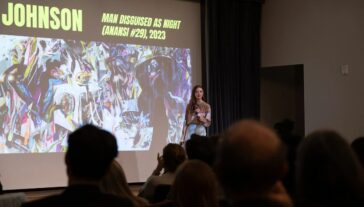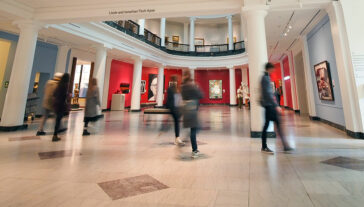Artist Yehrim Lee Bucks Tradition in Favor of Juicy Delights in “Dopamine Dressing,” Now on View at UMMA

“Should I fire this piece in the kiln anyway, or just throw it out and start over?”
That was the question abstract sculptor YehRim Lee posed to her Instagram followers while working on a piece she eventually called Three Hearts Are Trouble (pictured below). The unfired clay had collapsed under its own weight, and she wasn’t sure she liked the result. But when 98 percent of the poll respondents voted she should keep working on it, she did. “I thought, what’s wrong with those other 2 percent of people?” Lee said, laughing as she recounted the story.
The morning after the Penny Stamps Speaker Series talk, she was meeting with members of UMMA’s Student Advisory Board about a traditional upbringing that helped her find an untraditional artistic voice. She spoke not only of her current exhibition at the Museum, Dopamine Dressing, but also about her roots in South Korea.
Lee’s parents were both sculptors; they opened a studio together and specialized in onggi ware. These large pots, typically brown, have been used for several thousand years to store kimchi and other fermented foods. Lee spent time in her father’s studio as a small child, and eventually moved on to making traditional Buddha sculptures while in college. After graduating, she intended to “get away from clay” and applied to study abroad in China–but was placed in Jingdezhen, a city known as “the porcelain capital of the world.” Again, Lee found herself constantly surrounded by ceramics in styles that had hardly changed over thousands of years of production. It wasn’t until she came to the United States that the idea of “expressing yourself” through art really took hold in her, and she began to let go of the idea that she needed to work within the guidelines of conventional Asian ceramics.
The pieces in Dopamine Dressing, on view at UMMA through August 2023, swirl and swoop, some with scalloped edges and others with points sharp enough to take your eye out. Many have both.
“My husband says this one looks like salmon skin,” Lee said, motioning to a sculpture called, appropriately, Salmon Skin, which has a silvery sheen overlaying the pink surface. “And that one”–Candy Angle Green Small, a boxy, emerald green creation–”looks like a tree, so we had it up in our house for Christmas.”
More from UMMA



